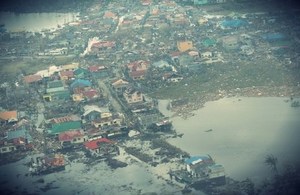Inmarsat (Philippines) Satcoms in Natural Disasters
Reducing the Impact of Natural Disasters by using Satcoms in the Philippines

Natural Disaster in the Philippines. Credit: Inmarsat.
Project Title
Reducing the Impact of Natural Disasters by using Satcoms
Target Country
Philippines
Project Lead
Inmarsat
Project consortium
Inmarsat, Satellite Application Catapult, Telecom Sans Frontières (TSF), TD International, Devex, CPRM, IEC
International partners
DSWD
Programme Summary
The Philippines suffers over 20 cyclones annually, as well as frequent volcanic eruptions and earthquakes. It is highly experienced at responding to rapid onset disasters, but resource constraints, infrastructure fragility, and the country’s geography means that the human and economic cost remains high, whilst the government’s reach is limited. A key lesson from Typhoon Yolanda in 2013 was the ineffective deployment of crisis communications. This project transforms disaster responses by:
- Prepositioning powerful but easily deployable equipment including Inmarsat’s new Global Xpress (GX) satellite equipment, supported by effective training.
- Rapid deployment at the disaster area will provide the national coordinating authority with the infrastructure to run national and local disaster response communications, at scale.
Objectives
The project objectives are:
- The capability to rapidly restore communications and increase command and control of recovery operations within 24 hours of occurrence of disaster.
- Measurable improvement to sub-national and local capacities in terms of disaster response - standard operating procedures on communications systems among provincial, city and municipal disaster risk reduction and management offices for the purpose of gathering information on disaster areas before, during, and after disasters.
- Reduction of the dependency of sub-national and local governments to National Government assets, specifically emergency telecoms.
- Improvements in survivorship, disease, and hardship.
- Lessening of economic damage through reinstatement of basic facilities as rapidly as possible.